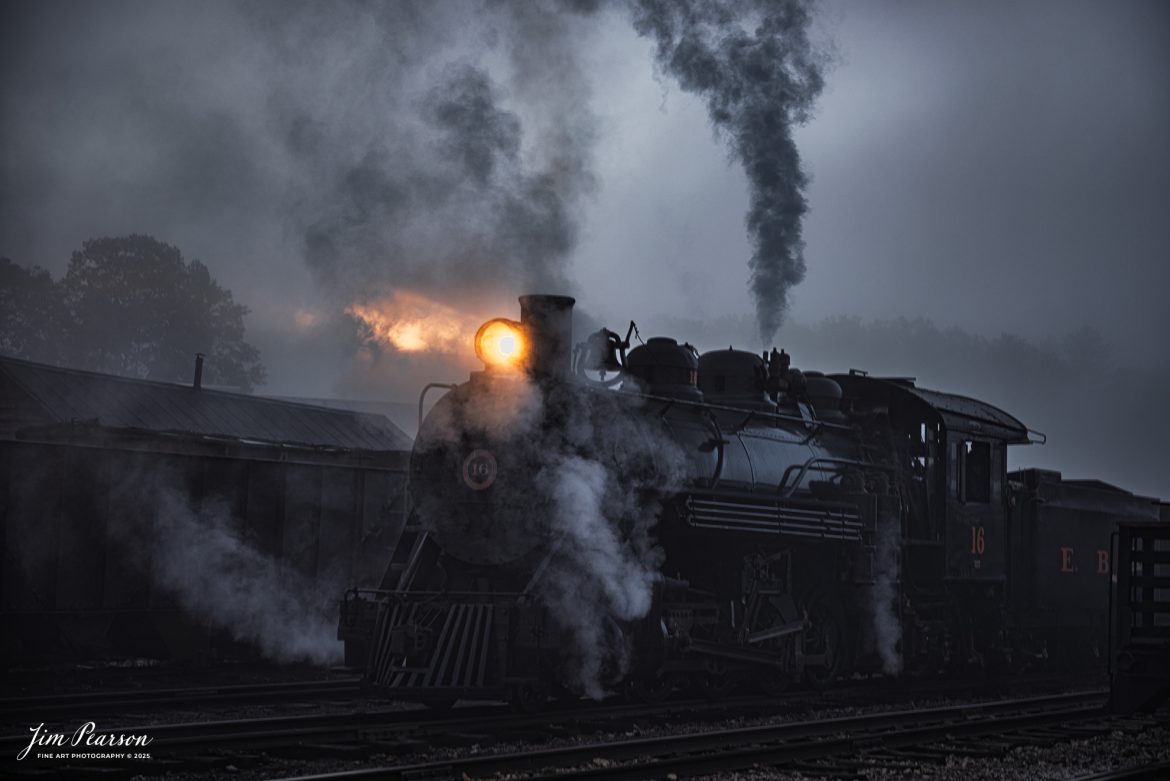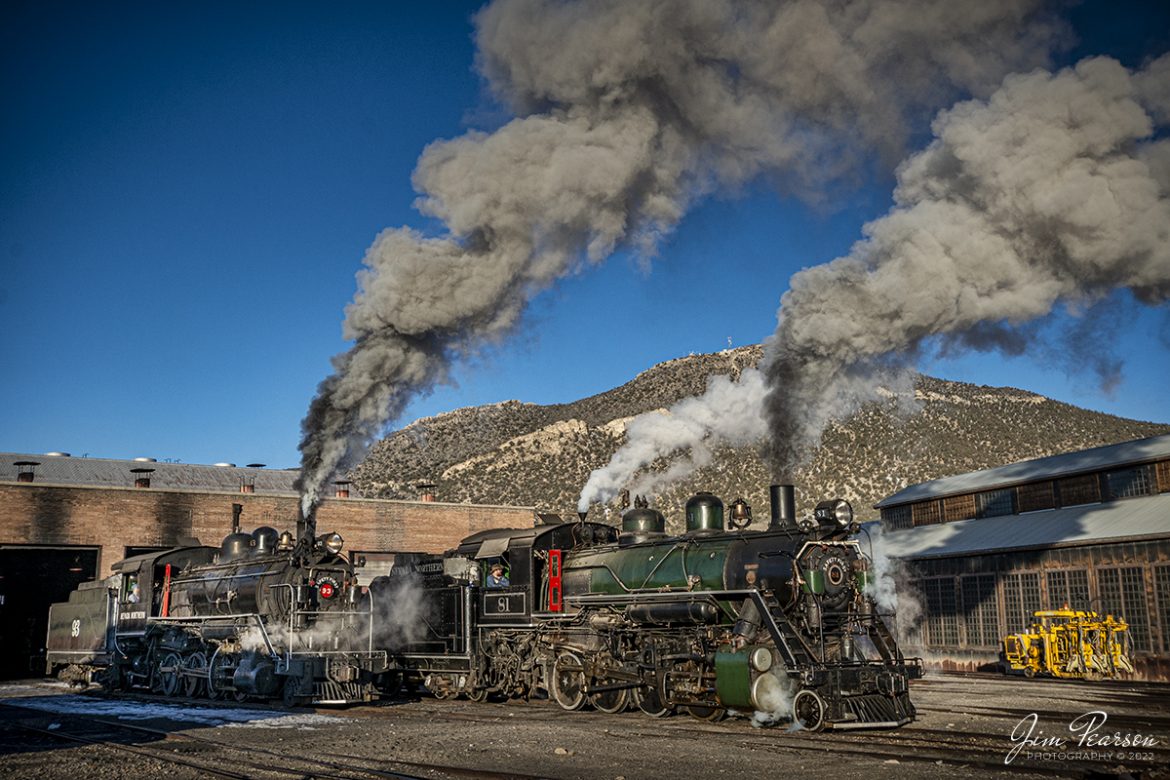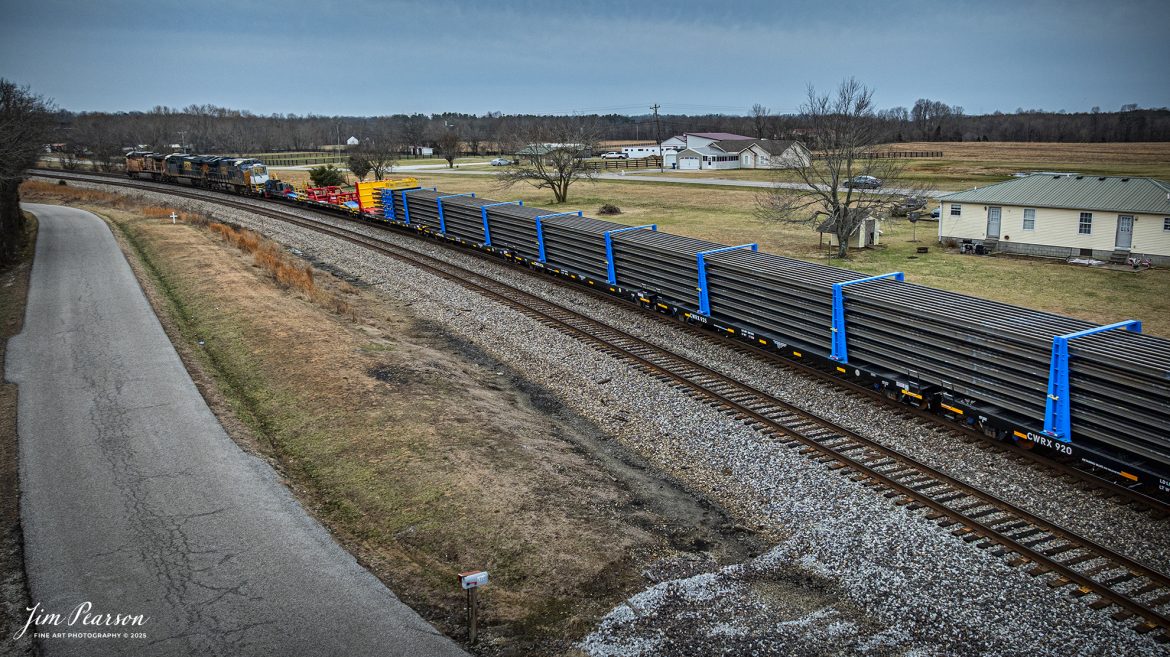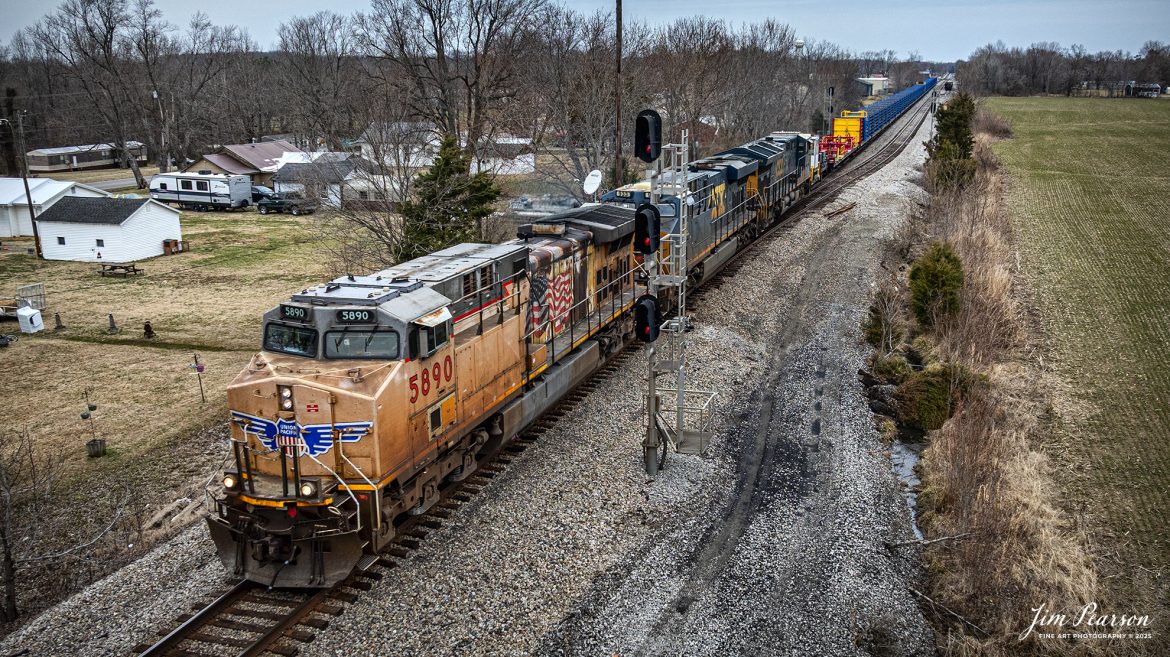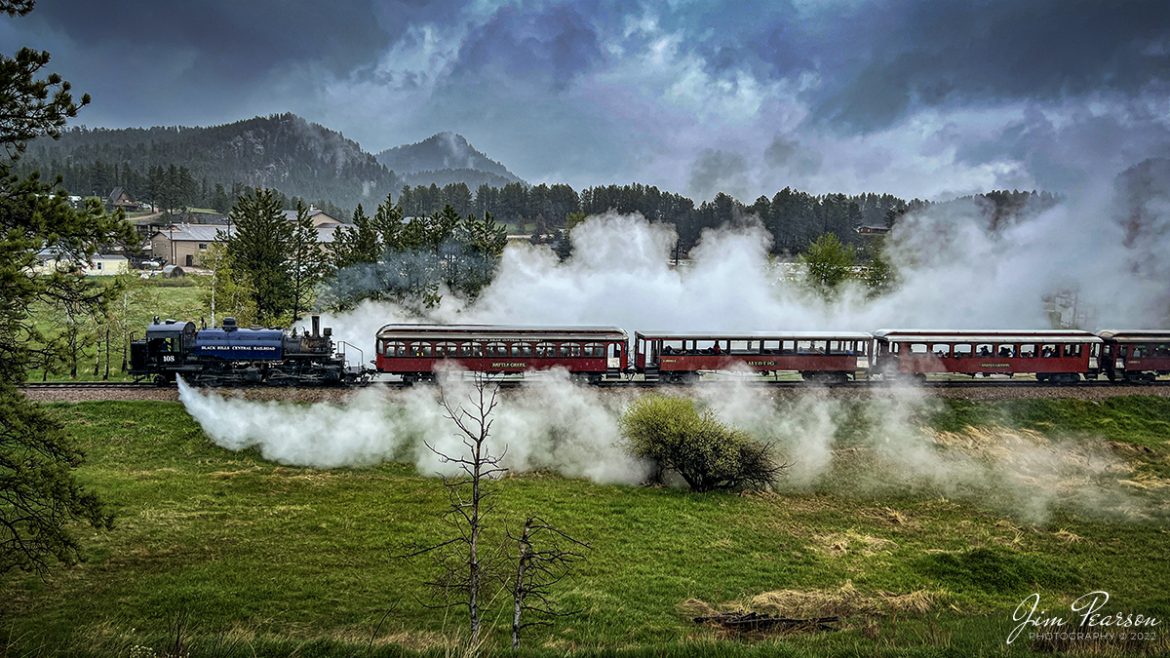September 1, 2018 – St. Louis-San Francisco Railroad steam locomotive 1630 sits in the station at the Illinois Railway Museum in Union, Illinois, waiting for it’s 8pm run, as the last light of day begins to fade from the sky.
According to Wikipedia, the locomotive was built in 1918 by the Baldwin Locomotive Works for use in Russia as a class Ye locomotive. However, it, along with approximately 200 other locomotives, remained in the United States, due to the inability of the Bolshevik government to pay for them, following the Russian Revolution.
1630 was converted from 5 ft (1,524 mm) Russian track gauge to 4 ft 8 1/2 in (1,435 mm) standard gauge. After being re-gauged, #1630 was sold to the USRA and was numbered 1147. Shortly after, 1147 was briefly leased for use on the Pennsylvania Railroad.
In 1920, the locomotive was sold to the St. Louis San Francisco Railway, where it was used as a mixed traffic engine. In 1951, the locomotive was sold to Eagle-Picher, who used it to haul lead ore from a mine to their smelter.
In 1967, the locomotive was donated to the Illinois Railway Museum, in Union, Illinois, where they began restoring it in 1972, it returned to operating condition in 1974 and made its first revenue run. Sometime after arriving at the museum, 1630 was restored from her Eagle Picher appearance back to her Frisco appearance. 1630 was taken out of service in 2004, and after more than six years undergoing repairs and a federally mandated rebuild, it was returned to operational condition on October 30, 2013.
On Memorial Day weekend 2014, the locomotive returned to excursion service. In 2016, the locomotive received a cylinder overhaul, which according to Steam department curator, Nigel Bennett, made the locomotive, “probably more powerful than she has been since her [sic] first arrival at IRM in the 1970s.” The locomotive, during Memorial Day weekend 2016, pulled 137 empty coal cars in storage at the museum as what was considered to be one of the longest revenue freight trains powered by a steam locomotive in at least 25 years as said by IRM’s Steam department curator.

![September 1, 2018 - St. Louis-San Francisco Railroad steam locomotive 1630 sits in the station at the Illinois Railway Museum in Union, Illinois, waiting for it's 8pm run, as the last light of day begins to fade from the sky.
According to Wikipedia, the locomotive was built in 1918 by the Baldwin Locomotive Works for use in Russia as a class Ye locomotive. However, it, along with approximately 200 other locomotives, remained in the United States, due to the inability of the Bolshevik government to pay for them, following the Russian Revolution.
1630 was converted from 5 ft (1,524 mm) Russian track gauge to 4 ft 8 1/2 in (1,435 mm) standard gauge. After being re-gauged, #1630 was sold to the USRA and was numbered 1147. Shortly after, 1147 was briefly leased for use on the Pennsylvania Railroad.
In 1920, the locomotive was sold to the St. Louis San Francisco Railway, where it was used as a mixed traffic engine. In 1951, the locomotive was sold to Eagle-Picher, who used it to haul lead ore from a mine to their smelter.
In 1967, the locomotive was donated to the Illinois Railway Museum, in Union, Illinois, where they began restoring it in 1972, it returned to operating condition in 1974 and made its first revenue run. Sometime after arriving at the museum, 1630 was restored from her Eagle Picher appearance back to her Frisco appearance. 1630 was taken out of service in 2004, and after more than six years undergoing repairs and a federally mandated rebuild, it was returned to operational condition on October 30, 2013.
On Memorial Day weekend 2014, the locomotive returned to excursion service. In 2016, the locomotive received a cylinder overhaul, which according to Steam department curator, Nigel Bennett, made the locomotive, "probably more powerful than she has been since her [sic] first arrival at IRM in the 1970s." The locomotive, during Memorial Day weekend 2016, pulled 137 empty coal cars in storage at the museum as what was considered to be one of the longest revenue freight trains powered by a steam locomotive in at least 25 years as said by IRM's Steam department curator.
- #jimstrainphotos #illinoisrailroads #steamtrains #nikond800 #railroad #railroads #train #railways #railway #illinoisrailwaymuseum #steamtrain](http://www.jimpearsonphotography.com/wp-content/uploads/2025/03/WEB-09.01.18-Frisco-1630-Steam-at-station-IRM-Union-IL-1170x781.jpg)
![Film Wednesday – 1993 – Today’s slide scans are from time that I spent at the Budapest-Nyugati Railway Station, in Budapest, Hungry. This shot is of a conductor filling out his paperwork, prior to his train departing.
According to Wikipedia, Budapest Nyugati station (Hungarian: Nyugati pályaudvar, pronounced [ˈɲuɡɒti ˈpaːjɒudvɒr]; lit. 'western railway station'), generally referred to simply as Nyugati, is one of the three main railway terminals in Budapest, Hungary. The station is on the Pest side of Budapest, accessible by the 4 and 6 tramline and the M3 metro line.
The station was designed by Auguste de Serres and was built by the Eiffel Company. It was opened on 28 October 1877. It replaced another station, which was the terminus of Hungary's first railway line, the Pest–Vác line (constructed in 1846). This building was demolished to construct the Grand Boulevard.
The station got its name from the adjacent Western Square ('Nyugati tér'), a major intersection where Teréz körút (Theresia Boulevard), Szent István körút (Saint Stephen Boulevard), Váci út (Váci Avenue), and Bajcsy-Zsilinszky út (Bajcsy-Zsilinszky Avenue) converge. The square also serves as a transport hub with several bus routes, tram routes 4 and 6, and a station on M3 of the Budapest Metro.
Beside the terminal and partially above its open area there is the WestEnd City Center shopping mall. Inside the station is a McDonald's restaurant which has been described as the "most elegant" McDonald's in the world.
The music video for Gwen Stefani's 2008 single Early Winter was partly shot at Nyugati. Starting in May 2016 the key scenes of the movie Terminal were shot over 27 nights.
Tech Info: Camera, Nikon F3, Ektachrome Slide Film, no other data recorded, Scanned with an PlusTek 82001i Film Scanner.
#slidescan #filmphotography #trains #railroads #jimpearsonphotography #FilmPhotography](http://www.jimpearsonphotography.com/wp-content/uploads/2025/03/WEB-1993-Conductor-Writing-at-Budapest-Hungry-1170x759.jpg)
![Film Wednesday – 1993 – Today’s slide scans are from time that I spent at the Budapest-Nyugati Railway Station, in Budapest, Hungry. This shot is a portrait of a worker that posed for me with his pipe!
According to Wikipedia, Budapest Nyugati station (Hungarian: Nyugati pályaudvar, pronounced [ˈɲuɡɒti ˈpaːjɒudvɒr]; lit. 'western railway station'), generally referred to simply as Nyugati, is one of the three main railway terminals in Budapest, Hungary. The station is on the Pest side of Budapest, accessible by the 4 and 6 tramline and the M3 metro line.
The station was designed by Auguste de Serres and was built by the Eiffel Company. It was opened on 28 October 1877. It replaced another station, which was the terminus of Hungary's first railway line, the Pest–Vác line (constructed in 1846). This building was demolished to construct the Grand Boulevard.
The station got its name from the adjacent Western Square ('Nyugati tér'), a major intersection where Teréz körút (Theresia Boulevard), Szent István körút (Saint Stephen Boulevard), Váci út (Váci Avenue), and Bajcsy-Zsilinszky út (Bajcsy-Zsilinszky Avenue) converge. The square also serves as a transport hub with several bus routes, tram routes 4 and 6, and a station on M3 of the Budapest Metro.
Beside the terminal and partially above its open area there is the WestEnd City Center shopping mall. Inside the station is a McDonald's restaurant which has been described as the "most elegant" McDonald's in the world.
The music video for Gwen Stefani's 2008 single Early Winter was partly shot at Nyugati. Starting in May 2016 the key scenes of the movie Terminal were shot over 27 nights.
Tech Info: Camera, Nikon F3, Ektachrome Slide Film, no other data recorded, Scanned with an PlusTek 82001i Film Scanner.
#slidescan #filmphotography #trains #railroads #jimpearsonphotography #FilmPhotography](http://www.jimpearsonphotography.com/wp-content/uploads/2025/03/WEB-1993-Conductor-at-Budapest-Hungry.jpg)

